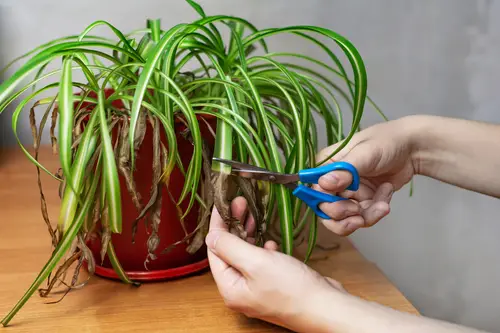Spider plants are popular houseplants known for their lush green foliage and easy-care nature. However, sometimes spider plants can start to die from the bottom up, which can be a cause for concern for plant owners.
In this article, we will explore the common causes of spider plant dying from the bottom up and provide tips on how to revive a dying spider plant.
Understanding spider plants is the first step in identifying the possible reasons for their decline. Spider plants are native to tropical and subtropical regions and prefer bright, indirect light.
They are resilient plants that can tolerate a range of conditions, but they thrive in well-draining soil and moderate to high humidity levels. When spider plants start to die from the bottom up, it is usually a sign that something is not right with their growing conditions.
Common causes of spider plant dying from the bottom up include overwatering, underwatering, root rot, pests, and diseases. Signs and symptoms of a dying spider plant can vary depending on the underlying cause, but they often include yellowing leaves, brown tips, and wilting foliage.
Proper watering, soil, and potting, light and temperature, nutrient needs, and pest control are essential factors in spider plant care and can help prevent and treat plant decline.
Key Takeaways
- Spider plants can start to die from the bottom up due to a variety of reasons, including overwatering, underwatering, root rot, pests, and diseases.
- Signs of a dying spider plant can include yellowing leaves, brown tips, and wilting foliage.
- Proper care, including watering, soil, and potting, light and temperature, nutrient needs, and pest control, can help prevent and treat spider plant decline.
Check out these other top picks:
Understanding Spider Plant
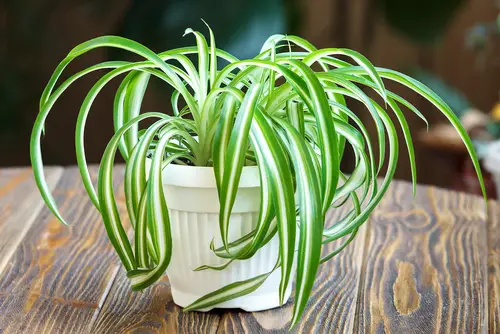
Spider plants, also known as Chlorophytum comosum, are native to South Africa. They are popular houseplants known for their attractive foliage and ability to produce plantlets, or baby spider plants, which can be easily propagated.
Spider plants have long, narrow leaves that grow in a rosette pattern from a central point. The leaves can be green or variegated with white or yellow stripes. In the right conditions, spider plants can produce small white flowers on long stems.
One of the reasons why spider plants are so popular as houseplants is because they are relatively easy to care for. They prefer bright, indirect light and well-draining soil. Overwatering can be a problem for spider plants, as they are susceptible to root rot. It is important to allow the soil to dry out between waterings.
If a spider plant is dying from the bottom up, it is likely due to a problem with the roots. Overwatering, poor drainage, or inadequate light can all contribute to root problems. Spider plants can also be sensitive to the type of water they are exposed to. Hard water, which contains high levels of minerals, can cause brown tips on the leaves.
To keep a spider plant healthy, it is important to provide it with the right conditions. This includes bright, indirect light, well-draining soil, and appropriate watering.
If a spider plant is struggling, it may be necessary to repot it into fresh soil or to prune away any dead or damaged leaves. With the right care, spider plants can thrive and produce beautiful foliage and plantlets.
Common Causes of Spider Plant Dying from Bottom Up
Spider plants are popular houseplants known for their long, narrow leaves and ability to thrive in a range of environments. However, it’s not uncommon for spider plants to start dying from the bottom up, which can be a concern for plant owners.
In this section, we’ll explore some common causes of spider plant dying from the bottom up.
1. Overwatering and Root Rot
One of the most common causes of spider plant dying from the bottom up is overwatering. When spider plants are overwatered, the soil becomes waterlogged, which can lead to root rot.
Root rot is a fungal disease that affects the roots of plants and can cause them to decay, turn brown or black, and eventually die. If left untreated, root rot can spread to the rest of the plant, causing it to die.
To prevent root rot, it’s important to ensure that the soil is well-draining and not waterlogged. Spider plants prefer soil that is moist but not waterlogged, so it’s important to establish a watering routine that allows the soil to dry out slightly between waterings.
Additionally, it’s important to avoid overfertilizing spider plants, as this can also lead to root rot.
2. Improper Care and Environment

Spider plants require specific care and environmental conditions to thrive. If these conditions are not met, the plant may start to die from the bottom up. For example, spider plants prefer bright, indirect light and moderate humidity. If the plant is placed in an area with low light or low humidity, it may start to die from the bottom up.
Similarly, spider plants are sensitive to hot and cold temperatures. If the plant is exposed to temperatures that are too hot or too cold, it may start to die from the bottom up.
Additionally, spider plants can be sensitive to chemicals in tap water, such as chlorine, which can cause the leaves to turn yellow and the plant to die from the bottom up.
3. Underwatering
While overwatering can be a problem for spider plants, underwatering can also cause them to die from the bottom up. When spider plants are underwatered, the leaves may turn yellow and start to die from the bottom up.
To prevent underwatering, it’s important to establish a watering routine that allows the soil to dry out slightly between waterings. Additionally, spider plants prefer soil that is moist but not waterlogged, so it’s important to avoid letting the soil dry out completely.
Signs and Symptoms of a Dying Spider Plant
Spider plants are popular indoor plants that are easy to grow and care for. However, they can still experience problems, and one of the most common issues is a dying spider plant. If you notice any of the following signs and symptoms, it may indicate that your spider plant is dying from the bottom up.
1. Yellowing Leaves
One of the first signs of a dying spider plant is yellowing leaves. This may indicate that the plant is not getting enough water or is being overwatered. Spider plants prefer to be kept moist but not waterlogged, so it’s important to find the right balance.
If the soil is too dry, the leaves may turn yellow and start to wilt. On the other hand, if the soil is too wet, the roots can rot, causing the leaves to yellow and fall off.
2. Wilting or Drooping Leaves
Another sign of a dying spider plant is wilting or drooping leaves. This may indicate that the plant is not getting enough water or is being overwatered. Spider plants prefer to be kept moist but not waterlogged, so it’s important to find the right balance.
If the soil is too dry, the leaves may wilt and start to droop. On the other hand, if the soil is too wet, the roots can rot, causing the leaves to wilt and droop.
3. Discolored Leaves
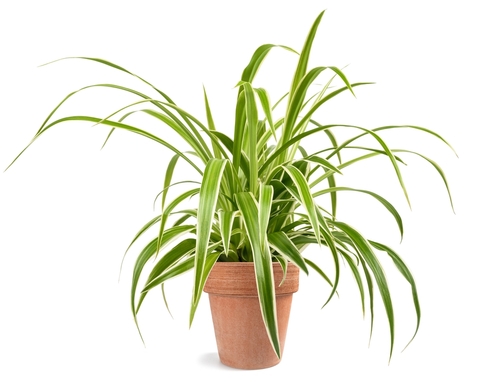
Discolored leaves are another sign of a dying spider plant. This may indicate that the plant is not getting enough nutrients or is being overfertilized. Spider plants do not require a lot of fertilizer, and too much can cause the leaves to turn brown and develop leaf tip burn.
If the leaves are discolored, it may be a good idea to check the soil pH and adjust the fertilizer accordingly.
4. Falling Off Leaves
If your spider plant is losing leaves, it may be a sign that it is dying from the bottom up. This can be caused by a variety of factors, including overwatering, underwatering, lack of nutrients, or pest infestations. If the leaves are falling off, it’s important to identify the underlying cause and take steps to address it.
Role of Water and Moisture
Water is essential for the survival of spider plants, but too much or too little can cause them to die from the bottom up. One of the most common reasons for spider plant death is overwatering. Spider plants prefer to be kept slightly moist but not waterlogged. When overwatered, the roots can rot, leading to the death of the plant.
It is important to ensure adequate drainage when watering spider plants. The plant should be watered thoroughly until water drains out of the bottom of the pot, but excess water should be immediately removed from the saucer. If the plant is left sitting in water, it can lead to root rot and other moisture-related problems.
Tap water can contain chemicals like chlorine and fluoride that can be harmful to spider plants. Distilled or filtered water is a better option for watering spider plants. Salt buildup can also be a problem when using tap water, so flushing the soil occasionally with distilled water can help prevent salt buildup.
Spider plants prefer moderate to high humidity levels, so misting the leaves with water can help increase humidity around the plant. Placing a tray of water near the plant can also help increase humidity levels.
Importance of Proper Soil and Potting
When it comes to keeping a spider plant healthy, proper soil and potting are crucial. Spider plants require well-draining soil to prevent root rot, which can cause the plant to die from the bottom up.
The first step in ensuring proper soil is selecting the right potting mix. A standard potting soil mix with a pH of 6.0 to 6.5 should work fine for the spider plant. It is essential to use fresh soil when repotting spider plants to avoid any potential disease or pest issues that can arise from using old soil.
Another critical factor in keeping spider plants healthy is choosing the right pot size. Spider plants prefer to be slightly root-bound, so it is best to choose a pot that is only slightly larger than the plant’s root ball. A pot that is too large can cause the soil to retain too much moisture, leading to root rot.
Good drainage is also essential for spider plants. When selecting a pot, make sure it has drainage holes to allow excess water to escape. If the current pot does not have drainage holes, consider repotting the plant into a container that does.
Proper potting technique is also crucial for spider plants. When potting a spider plant, make sure the soil is evenly distributed around the root ball and gently tamp it down to remove any air pockets. It is also essential to water the plant thoroughly after potting to ensure the soil is evenly moist.
Impact of Light and Temperature

Light and temperature play a crucial role in the growth of spider plants. Spider plants require bright, indirect light to thrive. If the plant is not receiving enough light, it can lead to yellowing leaves and stunted growth.
On the other hand, if the plant is exposed to direct sunlight, it can cause the leaves to burn and turn brown, starting from the tips and moving towards the base.
It is also essential to maintain a suitable temperature range for spider plants. Spider plants prefer temperatures between 60-75°F (15-24°C). If the temperature is too hot, it can cause the leaves to wilt and turn yellow. In contrast, if the temperature is too cold, it can cause the leaves to turn brown and eventually die.
The environment in which the spider plant is placed also affects its growth. Spider plants thrive in environments with high humidity levels, such as bathrooms. However, if the humidity level is too low, it can cause the tips of the leaves to turn brown and dry out.
Proper lighting is essential for the growth of spider plants. If the plant is not receiving enough light, it can lead to yellowing leaves and stunted growth. On the other hand, if the plant is exposed to direct sunlight, it can cause the leaves to burn and turn brown, starting from the tips and moving towards the base.
To ensure that the spider plant is receiving the right amount of light, it is recommended to place it near a window that receives bright, indirect light. If the plant is not receiving enough light, it can be supplemented with artificial lighting.
Nutrient Needs and Fertilizer Use
Spider plants require regular fertilization to maintain their health and growth. However, over-fertilizing can cause more harm than good, resulting in nutrient deficiencies or excess fertilizer buildup in the soil.
To avoid over-fertilization, it is recommended to fertilize spider plants once every month or two in the spring and summer. In the fall and winter, when the plant is in a dormant stage, stop fertilizing altogether.
When choosing a fertilizer, it is important to choose a balanced fertilizer that contains equal amounts of nitrogen, phosphorus, and potassium, such as a 20-20-20 fertilizer. In the fall and winter, a 10-10-10 fertilizer can be used instead.
If using a liquid fertilizer, mix it with water at a rate of 1 tablespoon per gallon. Be sure to follow the manufacturer’s instructions and avoid over-fertilizing, as this can lead to nutrient deficiencies or excess fertilizer buildup in the soil.
Signs of nutrient deficiency in spider plants include yellowing leaves or stunted growth. If this occurs, it may be necessary to adjust the fertilizer regimen or add additional nutrients to the soil.
In addition to nitrogen, phosphorus, and potassium, spider plants also require other essential minerals such as magnesium, iron, and calcium. It is important to ensure that the soil is rich in these minerals, as a deficiency can cause stunted growth and other health problems.
Dealing with Pests and Diseases

Spider plants are relatively easy to care for, but they are still susceptible to pests and diseases that can cause them to die from the bottom up. Here are some common pests and diseases that can affect spider plants and how to deal with them.
Pests
Spider mites, aphids, whiteflies, and fungus gnats are common pests that can infest spider plants. These pests can cause damage to the leaves and stems of the plant, which can lead to the plant dying from the bottom up.
To deal with spider mites and aphids, use a neem oil spray or insecticidal soap. These products can be found at most garden centers and are safe to use on spider plants.
For whiteflies, use yellow sticky traps to catch the adult flies. For fungus gnats, allow the soil to dry out between waterings and use yellow sticky traps to catch the adult gnats.
Insect infestations can be prevented by keeping the spider plant in a well-ventilated area and avoiding overwatering. Overwatering can lead to mold growth, which can attract pests.
Diseases
Spider plants can also be affected by diseases such as root rot, leaf spot, and powdery mildew. These diseases can cause the plant to wilt and die from the bottom up.
To prevent diseases, make sure the spider plant is not overwatered and is kept in a well-ventilated area. If the plant does contract a disease, remove the affected leaves and treat the plant with a fungicide. Repotting the plant with fresh soil can also help prevent the spread of disease.
Reviving a Dying Spider Plant
When a spider plant is dying from the bottom up, it is a sign that something is wrong with the plant. However, there are ways to revive a dying spider plant and bring it back to life. Here are some steps to take to revive a dying spider plant.
Identify the Problem
The first step in reviving a dying spider plant is to identify the problem. There are several reasons why a spider plant may be dying from the bottom up, including:
- Overwatering
- Underwatering
- Lack of nutrients
- Pest infestation
- Lack of light
Once the problem is identified, it can be addressed accordingly.
Care for the Plant

To revive a dying spider plant, it is important to provide it with proper care. This includes:
- Watering the plant properly: Spider plants prefer to be slightly dry between watering. Overwatering can lead to root rot, which can kill the plant. Underwatering can cause the leaves to turn brown and dry up. Water the plant when the top inch of soil is dry to the touch.
- Providing proper light: Spider plants prefer bright, indirect light. If the plant is not getting enough light, it may become weak and spindly. Move the plant to a brighter location if necessary.
- Fertilizing the plant: Spider plants benefit from regular fertilization during the growing season. Use a balanced fertilizer every two weeks during the growing season.
- Pruning the plant: Spider plants can become overcrowded, which can lead to a lack of energy and poor growth. Prune the plant as needed to promote healthy growth.
Transplant the Plant
If the spider plant is severely damaged, it may need to be transplanted. Transplanting the plant can provide it with fresh soil and more space to grow.
To transplant a spider plant, follow these steps:
- Choose a pot that is one size larger than the current pot.
- Fill the new pot with fresh potting soil.
- Gently remove the spider plant from its current pot, being careful not to damage the roots.
- Place the plant in the new pot and fill in the gaps with soil.
- Water the plant thoroughly.
Propagate the Plant
If the spider plant is beyond repair, it may be time to propagate the plant. Propagating a spider plant is easy and can be done in several ways, including:
- Plantlets: Spider plants produce plantlets that can be removed and planted in their own pots.
- Stem cuttings: Cut a stem from the spider plant and plant it in a pot with fresh soil.
Dormant Period
Spider plants may enter a dormant period during the winter months. During this time, the plant may appear to be dying, but it is simply conserving energy. Reduce watering and fertilization during the dormant period and resume normal care in the spring.
Reviving a dying spider plant requires patience and proper care. By identifying the problem, providing proper care, and taking steps to revive the plant, it is possible to bring a dying spider plant back to life.
Preventive Measures for Future Care
To prevent spider plants from dying from the bottom up, it is important to take preventive measures for future care. Here are some tips to keep spider plants healthy:
1. Care
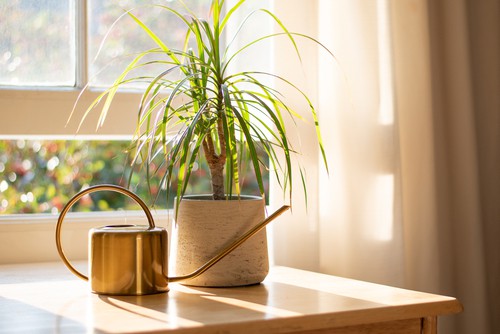
Spider plants are easy to care for, but they do need some attention. Regularly inspect the plant for any signs of disease or pests. Remove any dead or damaged leaves to prevent the spread of disease.
2. Watering
Overwatering or underwatering can cause spider plants to die from the bottom up. The soil should be moist but not soggy. Water the plant when the top inch of soil is dry. Avoid getting water on the leaves, as this can cause them to rot.
3. Light
Spider plants prefer bright, indirect light. They can also tolerate low light conditions, but they may not grow as well. Keep the plant away from direct sunlight, as this can cause the leaves to burn.
4. Soil
Spider plants prefer well-draining soil. Use a potting mix that is specifically formulated for indoor plants. Avoid using garden soil, as it can be too heavy and may not drain well.
5. Fertilizer
Spider plants do not need a lot of fertilizer. Feed the plant once a month during the growing season with a balanced fertilizer. Avoid overfertilizing, as this can cause the leaves to turn yellow.
6. Environment
Spider plants prefer warm temperatures and high humidity. Keep the plant away from cold drafts and air conditioning vents. Use a humidifier or mist the leaves regularly to increase humidity.
7. Drainage
Good drainage is important for spider plants. Make sure the pot has drainage holes and use a saucer to catch excess water. Do not let the plant sit in standing water, as this can cause the roots to rot.
8. Repotting
Spider plants should be repotted every 2-3 years. Use a pot that is one size larger than the current pot and use fresh potting soil. Gently loosen the roots and remove any dead or damaged roots before repotting.
9. Diseases
Spider plants are generally resistant to disease, but they can be susceptible to root rot if they are overwatered. To prevent root rot, make sure the soil is well-draining and avoid overwatering.
Frequently Asked Questions
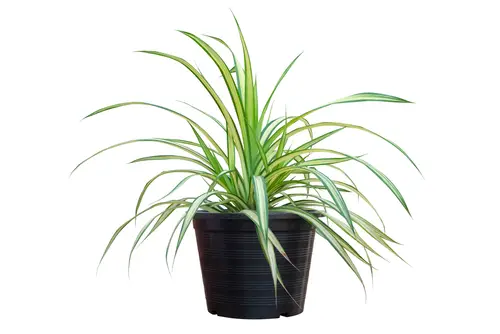
Why is my spider plant pale and limp?
A spider plant may become pale and limp due to several reasons such as overwatering, underwatering, lack of nutrients, or pests. Overwatering can lead to root rot, which affects the plant’s ability to absorb water and nutrients.
Underwatering, on the other hand, causes the leaves to droop and turn yellow. Lack of nutrients can also cause the plant to become pale and limp. Spider mites and mealybugs are common pests that can damage the plant, causing it to lose its vigor.
Why is my spider plant dying after repotting?
Repotting can be stressful for a spider plant, and if not done correctly, it can cause the plant to die. One of the common reasons why a spider plant may die after repotting is root damage. When repotting, it’s important to be gentle with the roots and avoid breaking or tearing them.
Another reason could be the use of the wrong soil type or pot size. Spider plants prefer well-draining soil, and a pot that’s too large can cause the soil to retain too much moisture, leading to root rot.
How to save a dying spider plant?
To save a dying spider plant, it’s important to identify the cause of the problem. If the plant is suffering from root rot, it’s important to remove the damaged roots and repot the plant in fresh soil.
If the plant is suffering from pests, it’s important to treat it with an appropriate insecticide. In some cases, the plant may need more light or nutrients. Pruning the damaged leaves and providing the plant with the right care can help it recover.
How to save spider plant from root rot?
To save a spider plant from root rot, it’s important to identify the problem early and take action. The first step is to remove the plant from the soil and inspect the roots. If the roots are brown and mushy, they are likely damaged by root rot.
Remove the damaged roots with a clean pair of scissors or shears and repot the plant in fresh soil. Avoid overwatering the plant and make sure the soil is well-draining.
Spider plant lost all leaves, what can I do?
If a spider plant has lost all its leaves, it’s important to identify the cause of the problem. Lack of light or nutrients, pests, or disease can cause a spider plant to lose its leaves. If the plant is still alive, it’s possible to revive it by providing it with the right care.
Move the plant to a brighter location, provide it with the right amount of water and nutrients, and treat it for pests or disease if necessary.
Can a spider plant recover from root rot?
A spider plant can recover from root rot if the problem is identified early and the right action is taken. Remove the damaged roots, repot the plant in fresh soil, and avoid overwatering.
Provide the plant with the right amount of light and nutrients and monitor it closely for signs of recovery. In some cases, the plant may take some time to recover, but with the right care, it can regain its health.

Hey, I’m Lisa and I’ve been an avid gardener for over 30 years. I love writing, talking and living in the garden! Feel free to connect with me on my socials below

